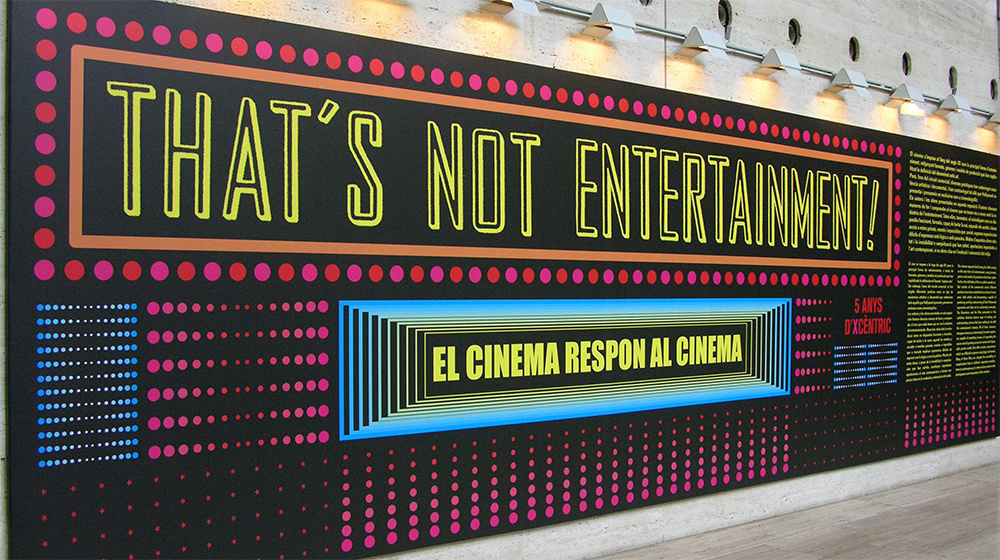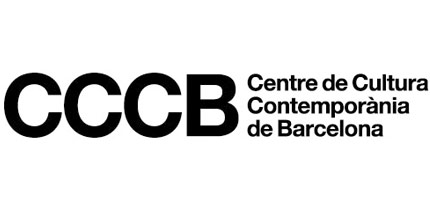5 years of Xcentric
Exhibition
That's not entertainment!
Cinema begets Cinema
When the cinema became a great entertainment factory, an industry that recruits creators and homogenizes tastes, it produced some small big reactions: subversive, ironic, abstract, alternative and minimalist. Producing film could no longer be the same for a generation formed emotionally and intellectually in front of cinema and television screens. Film answers film.
The exhibition "That's not entertainment! Cinema begets Cinema", presents the cinema of experimentation and social and artistic commitment: a form of cinema that is the product of rage or reflection, that does not seek to please the tastes or the opinions of a majority, that is motivated by the urgency of transmitting something important, something that will open our eyes, move us and expand our knowledge.
An exhibition can go beyond the screenings and set the works, movements and filmmakers in the context of the spirit that inspires them. Here, cinema takes the form of texts, images and references—technical, social or political—that illustrate its raison d'être.
It will present installations and works that, despite their invisibility on the commercial circuit, are key pieces of contemporary art, by filmmakers such as Gustav Deutsch, Peter Kubelka, Stan Brakhage, Jonas Mekas, Kenneth Anger, Kurt Kren, Jean Genet, Guy Debord, Frank Mouris, Jean-Luc Godard, Kevin Brownlow, Chantal Akerman, Carles Santos, Mathias Müller and Martin Arnold.
Curators: Andrés Hispano, Antoni Pinent
Participants: Chantal Akerman, Kenneth Anger, Stan Brakhage, Guy Debord, Gustav Deutsch, Jean Genet, Jean-Luc Godard, Kurt Kren, Peter Kubelka, Jonas Mekas, Frank Mouris, Matthias Müller, Caroline Mouris, Carles Santos, Andy Warhol
This activity is part of 5 years of Xcentric
Introduction
In the course of the 20th century, the cinema established itself as the number one form of entertainment, with a whole series of formats, genres and models of production that came to define the seventh art.
Outside the commercial circuit, however, various practices have become artistic and documentarian resistance, contravening everything that Hollywood represents and claims as its own.
The creators and the works presented in this exhibition illustrate various ways of making and understanding cinema that have nothing to do with the entertainment industry. All of them, however, coincide in seeing it as a fascinating, educational mechanism that is capable of overturning reason, expanding the senses and leading us into private, remote, impossible worlds that often represent experiences that are difficult to express by means of logic or words. Many of these works are, despite the invisibility or parasitisation they are subjected to, important contributions to contemporary art, if not key works in the evolution and reinvention of the medium.
Film is a young art, with barely more than a hundred years behind it. Many of its expressions are still reactions, experiments and explorations for which the cinema itself is a creative motivation.
Film Ist
A spectacular eight-screen installation shows just how the cinema reinvented our imaginary.
Film Ist (1-6) / (7-12) is a film by Gustav Deutsch (Vienna, 1952) made between 1998 and 2002. The film is made up of sequences taken from scientific films and images from the early years of the cinema, represented by the silent movies.
Film Ist defines cinema by the way in which it reinvents how we see, our imaginary and our narrative forms. In order to achieve this, Deutsch chronologically has recourse to film and to the uses given to the cinema, piecing together numerous episodes to compose an anthological kaleidoscope of its magic and potential.
The storyline is the light
Screening of the film Arnulf Rainer , the key work of Peter Kubelka 's metric cinema, in which cinema becomes an experience of light, sound and silence that refers back to the origin of its very nature.
The exhibition offers this film as both a screening and an artistic experience, since Kubelka enables us to see the film hung on the wall, as though it were a score or an abstract painting.
There is a form of cinema that investigates the working of its technical mechanism and the viewer's perceptive physics. It is a form of cinema that shuns stories and of which light can be said to be the protagonist.
This cinema is based on the simple alternation of opaque and transparent stills that returns us to the very essence of the medium, which can only render visible that which it partially conceals. This cinema without a storyline also insists on the same expressive, experiential appreciation that we recognise in painting and music.
Without a camera
Two films by Stan Brakhage, an audiovisual and two tables with original material, show us cinema made without a camera, working directly on the film.
Cinema does not depend only on what is filmed. Film is also a physical support on which we can act with our hands, painting it, scratching it or sticking objects to it.
This process gives cinema a domestic, artistic and organic dimension that contrasts with the myth of the cinema as a “dream factory”, requiring actors, stories, sets, technicians and big budgets.
Look at me
Perhaps the most revolutionary and simplest cinematographic practice is the form by means of which we take the camera to talk about ourselves, to show our world and our immediate environment, either as an exercise in direct realism or as radical subjectivism.
The “non-professional” formats, 16 mm and Super-8 in particular, turned the cinema into a documentary tool that could make the author, his or her surroundings or internal landscapes the subject. The artist, the amateur and the documentary-maker gave back to the cinema a potential previously realized by photography: the subjective telling of our lives and impressions using spontaneous, direct registers.
Some of the creators included: Chantal Akerman, Frank and Caroline Mouris.
Without permission
Various filmmakers such as Joseph Cornell, Mathias Müller, Martin Arnold and Jean-Luc Godard demonstrated the creative possibilities that emerged from appropriation as a creative resource.
Existing images and sequences become tools in the hands of creators who wrought new things out of them: their own, often ironic takes.
This form of recycling sees the cinema as a shared legacy and its images, recognisable or otherwise, as fragments scattered throughout our memory, on the verge of being recovered in the same way that a word or a found object is incorporated into a poem or a sculpture.
Banking on our gullibility
Two screens dialogue with fragments of monstrously false documents to which false documentaries respond.
The shock strategy
An audiovisual shown on several screens centres on the use of provocative and taboo images.
Some of the creators included: Jean Genet, Kenneth Agger, Georges Franju, Kurt Kren, Andy Warhol.
The Xcentric Archive
The visit to the exhibition ends with the Xcentric Archive. More information on the 14 th page.
Related contents
Report "That's not entertainment! Cinema begets Cinema"
This exhibition presents the cinema of experimentation and social and artistic commitment: a form of cinema that is the product of rage or reflection, that does not seek to please the tastes or the opinions of a majority, that is motivated by the urgency of transmitting something important, something that will open our eyes, move us and expand our knowledge.



